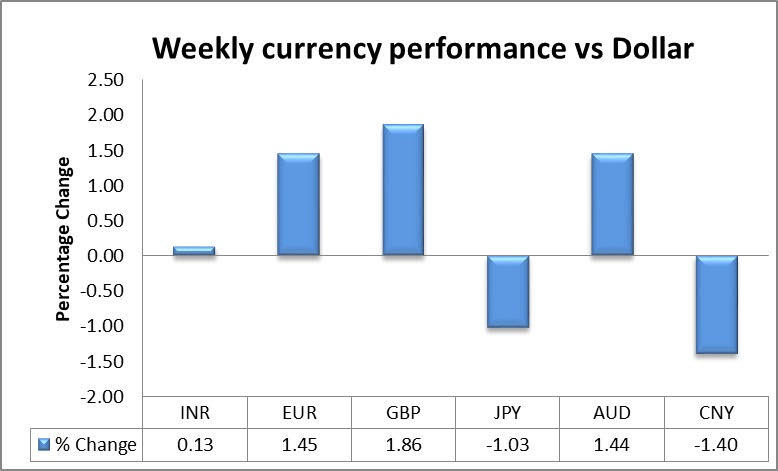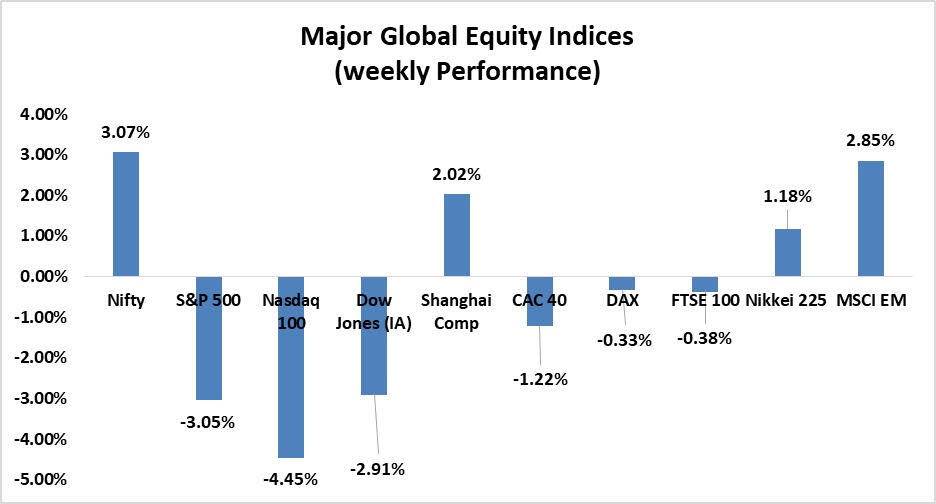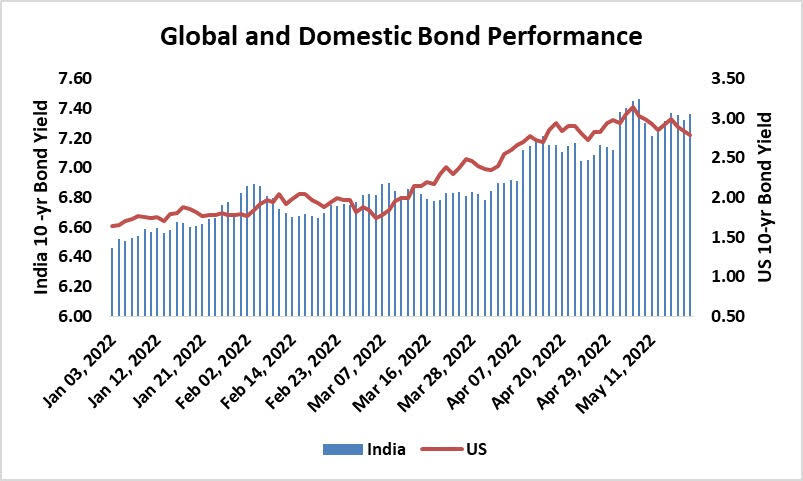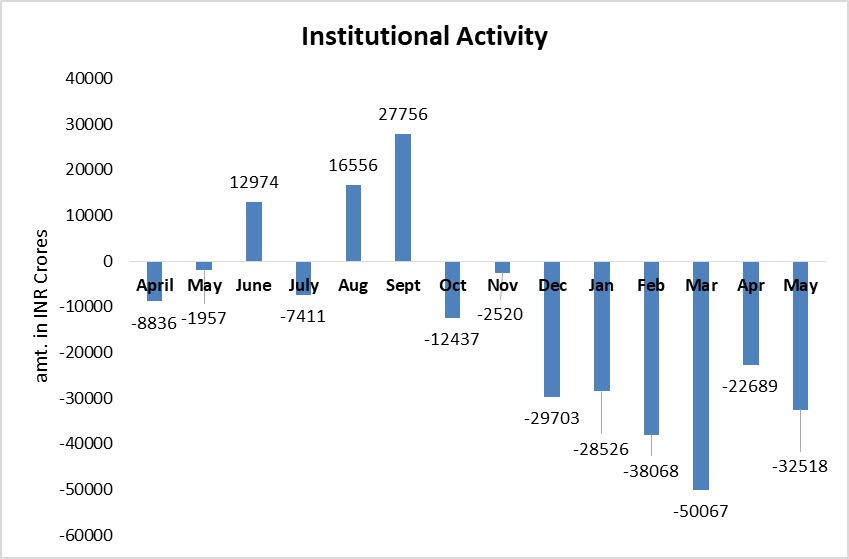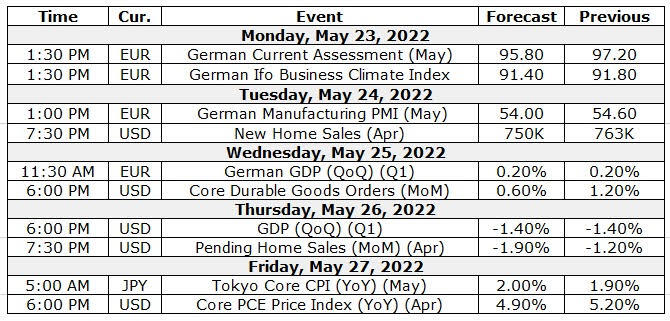Key Highlights
- U.K. consumer confidence hits all-time low but retail sales bounce.
- Japan's GDP shrinks as surging costs raise spectre of a deeper downturn.
- Eurozone Q1 GDP growth rate revised upward to end-2021 pace.
- WPI inflation rises further to 15.08% in April from 14.55% a month back.
- RBI MPC minutes show the need for front-loading interest rate hikes in upcoming meetings, experts say.
- China cuts mortgage lending rate by the record as lockdowns hit the economy.
USD/INR Weekly performance & Outlook
The USD/INR pair made a gap up opening at 77.67 levels and remained volatile during the week. The pair closed the last trading session at 77.54. The USD/INR pair initially rose tracking the strong dollar, along with the prospects for a more aggressive policy tightening by the Fed. However, later in the week, the pair was seen trading in a range-bound manner as investors lacked direction. The U.S. dollar edged slightly lower but remained above the 103 mark, handing back some of the previous session's gains although the safe haven remained in demand with risk sentiment fragile. The pair is expected to trade with a neutral to bullish bias amid the unending Russia-Ukraine war and further anticipated escalation in the war situation after Sweden and Finland officially joined NATO which will keep the dollar in demand for a little longer. The Reserve Bank of India’s continued intervention to protect the level of 77.50-77.70 level, capped any major gains in the USD/INR pair. The Centre on Saturday finally slashed excise duty on petrol and diesel by Rs 8 and Rs 6 per litre respectively. This will reduce the price of petrol by Rs 9.5 per litre and of diesel by Rs 7 per litre. This is expected to cool off the surging inflation pressure in the near term. The RBI surplus transfer to the government was sharply down at ₹30,307 crores and the added cut in the petrol prices is expected to impact the Govt revenue and thereby Budget maths. The focus will be on the US GDP data and FOMC meeting minutes expected to be released later in the week.
Eurozone April inflation revised down to 7.4%; still a record high.
EURUSD:
The EURUSD pair opened the week at 1.0405 and moved upwards to touch a weekly high of 1.0607 levels. The pair remained volatile and closed the week at 1.0562 levels. The pair majorly remained above the 1.05 level during the week on the back of a weaker US dollar, despite a risk-aversion environment that usually benefits the dollar. In the last trading session, the Euro traded a tad down against the US dollar on worries over rising inflation and investors' weak risk sentiments. ECB unveiled its last monetary policy minutes, in which ECB hawks are calling the shots. The minutes confirmed the increasingly hawkish tone of many ECB members since the April meeting. There seems to be an eerie feeling that the ECB is acting too late and quickly needs to join the bandwagon of monetary policy normalization. This means that the question is no longer whether the ECB should hike interest rates in July but by how much. The focus will be on the PMI data from Eurozone, Eurogroup Meetings, and ECB Financial Stability Review. The pair is expected to trade with a sideways bias.
UK inflation hits a 40-year high of 9.0%, squeezing households harder.
GBPUSD:
The pair has rallied from a low of 1.2217 seen at the beginning of the week and continued to trade on an upward trajectory. The pair saw a high of 1.2524 during the week and closed the week at 1.2489. A pullback in the dollar index and better-than-expected UK macro data also supported the pound. The UK Office for National Statistics reported that Retail Sales unexpectedly rose by 1.4% in April as against consensus estimates pointing to a drop of 0.2%. Market data suggests another 25 bps hike is priced in for the next meeting on June 16. Looking ahead, the swaps market is pricing in 150 bps of total tightening over the next 12 months that would see the policy rate peak near 2.50%, steady from the start of last week. Brexit issues cloud over cable as the EU ambassador to the UK has rejected the UK's demand that the Northern Ireland protocol is rewritten, and issued a blunt warning of retaliation if the government passes a law disapplying aspects of the agreement. The pair is expected to trade with a neutral to bullish bias.
Powell says the Fed will not hesitate to keep raising rates until inflation comes down.
Dollar Index:
Following Thursday’s deep pullback to 2-week lows in the sub-103.00 region, the index regained some ground lost amidst the mixed note in the US cash markets and the absence of a clear direction in the broad risk appetite trends. In the meantime, investors remain vigilant on the possibility of a “hard landing” of the US economy amidst elevated inflation and the Fed’s more aggressive tightening of its monetary conditions. According to CME Group’s FedWatch Tool, the probability of a 50 bps rate hike at the June 13 meeting is at 93% and 85% when it comes to the July 27 event. The dollar attempts a mild rebound to the 103.00 neighborhood following the multi-session drop recorded on Thursday. In the meantime, and supporting the dollar, appears investors’ expectations of a tighter rate path by the Federal Reserve and its correlation to yields, the current elevated inflation narrative, and the solid health of the labour market. On the negative for the dollar turn up the incipient speculation of a “hard landing” of the US economy as a result of the Fed’s more aggressive normalization. The dollar index is expected to trade with a neutral to bullish bias.
Domestic and Global Equities:
Domestic Equities:
Indian indices bounced back in style from the previous slumps in the last session of the week as both the Sensex and Nifty advanced close to 3%, tracking positive trends from Asian peers. Asian investors reacted positively to the Chinese central bank's decision to reduce its rate on a five-year loan, which would shore up weak housing sales by cutting mortgage costs. On a weekly basis, Nifty Metal and Nifty Auto were the biggest gainers whereas Nifty IT was the only loser. With concerns over an economic slowdown and rate hikes across the globe, investors will continue to invest with caution.
Global Equities:
Global equity markets rebounded after the S&P 500 pared losses that briefly took it into the bear market territory, as investors unease about Federal Reserve policy tightening to curb inflation kindled fears of a recession. Shares rebounded in Europe and Asia after China cut a key lending benchmark to bolster its weakening economy, helping initially to drive gains on Wall Street. While a late-day rally stopped the S&P 500 from confirming a bear market, the gloom on Wall Street led the benchmark to fall for the seventh consecutive week, an event that has occurred only five times since 1928, according to S&P Dow Jones Indices. Overall, global stock markets have seen another volatile week as recession fears gripped investors after weak Chinese retail sales data and dismal results from big US retailers highlighted the impact of surging inflation. Shares rose in Japan, South Korea, Australia, Hong Kong, and Shanghai.
Domestic and Global Bonds:
Domestic Bonds:
Indian government bonds have experienced much turbulence over the last couple of weeks, see-sawing between considerable gains and losses as traders have reacted to a wide range of contrasting developments. The elevated inflation, surging crude prices, and other global cues kept the domestic bond market under pressure during the week. India's 10-year benchmark closed the week at 7.359%. One of the members of India's rate-setting Monetary Policy Committee stated that there is a need to front-load rate hikes as higher long-term yields can affect private Capex spending.
Global Bonds:
The yield on the benchmark 10-year U.S. Treasury note has moved down to 2.79% from May peaks of 3.2% on expectations that forthcoming U.S. rates by the Federal Reserve in June and July will be capped at a half-percentage point each round, instead of the initially-speculated three-quarter point. Yet, with rate expectations often moving on a dime, yields could jump too.
Monthly FPI Net Investments:
Since October last year, FPIs have sold equities worth nearly 2 trillion rupees with 4 of the eight months seeing selling of over 30,000 crore rupees each. That said, what has worsened the correction is the relentless selling by foreign portfolio investors for eight consecutive months. Despite retail investors and domestic institutional investors giving muscle to the market, FPIs are having an upper hand. Soaring oil prices and earnings downgrades are expected to keep market confidence muted in the near term.
Macro-economic calendar
This report has been prepared by IFA Global. IFA Global shall not be in any way responsible for any loss or damage that may arise to any person from any inadvertent error in the information contained in this report. IFA Global nor any of directors, employees, agents or representatives shall be held liable for any damages whether direct, indirect, special or consequential including lost revenue or lost profits that may arise from or in connection with the use of the information. No liability whatsoever is accepted for any loss arising (whether direct or consequential) from any use of the information contained in this report. This statement, prepared specifically at the addressee(s) request is for information contained in this statement. All market prices, service taxes and other levies are subject to change without notice. Also the value, income, appreciation, returns, yield of any of the securities or any other financial instruments mentioned in this statement are based on current market conditions and as per the last details available with us and subject to change. The levels and bases of, and reliefs from, taxation can change. The securities / units / other instruments mentioned in this report may or may not be live at the time of statement generation. Please note, however, that some data has been derived from sources that we believe to be reliable but is not guaranteed. Please review this information for accuracy as IFA Global cannot be responsible for omitted or misstated data. IFA Global is not liable for any delay in the receipt of this statement. This information is strictly confidential and is being furnished to you solely for your information. This information should not be reproduced or redistributed or passed on directly or indirectly in any form to any other person or published, copied, in whole or in part, for any purpose. This report is not directed or intended for distribution to, or use by, any person or entity who is a citizen or resident of or located in any locality, state, country or other jurisdiction, where such distribution, publication, availability or use would be contrary to law, regulation or which would subject IFA Global to any registration or licensing requirements within such jurisdiction. The information given in this report is as of the date of this report and there can be no assurance that future results or events will be consistent with this information. IFA Global reserves the right to make modifications and alterations to this statement as may be required from time to time. However, IFA Global is under no obligation to update or keep the information current. Nevertheless, IFA Global is committed to providing independent and transparent information to its client and would be happy to provide any information in response to specific client queries. Neither IFA Global nor any of its directors, employees, agents or representatives shall be liable for any damages whether direct, indirect, special or consequential including lost revenue or lost profits that may arise from or in connection with the use of the information. The information provided in these report remains, unless otherwise stated, the copyright of IFA Global. All layout, design, original artwork, concepts and other Intellectual Properties, remains the property and copyright IFA Global and may not be used in any form or for any purpose whatsoever by any party without the express written permission of the copyright holders.
Recommended Content
Editors’ Picks
EUR/USD stays weak near 1.0650 ahead of Eurozone PMI data

EUR/USD remains on the back foot near 1.0650 in European trading on Tuesday. Resurgent US Dollar demand amid a cautious risk tone weighs on the pair. Investors stay wary ahead of the preliminary Eurozone and US business PMI data.
GBP/USD eases below 1.2350, UK PMIs eyed

GBP/USD is dropping below 1.2350 in the European session, as the US Dollar sees fresh buying interest on tepid risk sentiment. The further downside in the pair could remain capped, as traders await the UK PMI reports for fresh trading impetus.
Gold price flirts with $2,300 amid receding safe-haven demand, reduced Fed rate cut bets

Gold price (XAU/USD) remains under heavy selling pressure for the second straight day on Tuesday and languishes near its lowest level in over two weeks, around the $2,300 mark heading into the European session.
PENDLE price soars 10% after Arthur Hayes’ optimism on Pendle derivative exchange

Pendle is among the top performers in the cryptocurrency market today, posting double-digit gains. Its peers in the altcoin space are not as forthcoming even as the market enjoys bullish sentiment inspired by Bitcoin price.
Focus on April PMIs today

In the euro area, focus today will be on the euro area PMIs for April. The previous months' PMIs have shown a return of the two-speed economy with the service sector in expansionary territory and manufacturing sector stuck in contraction.
